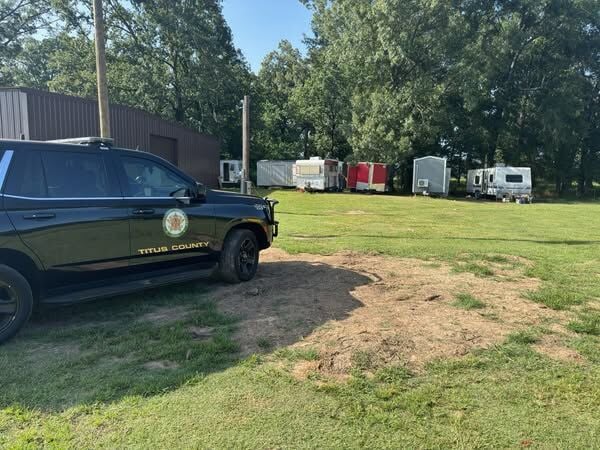Where can you catch a ride in a tank? Virginia’s American Armoured Foundation Tank Museum, of course
Published 8:12 am Saturday, July 9, 2016

- The American Amoured Foundation Tank Museum has headgear from around the world, including some from the 1600s. (Photo by Greg Kahn for The Washington Post)
“Seven … eight … zero … zero … zero … three!”
Dan Gasser calls out the numbers in a booming, stadium-beer-vendor voice. His wife, Natasha, dips her right hand into a glass bowl and pulls out another winning ticket.
“Seven … seven … nine … eight … three … six!” Dan shouts.
It’s raffle time at the family-owned and -operated American Armoured Foundation Tank Museum in Danville, Virginia, a 300,000-square-foot former milling factory that contains more than five football fields’ worth of steel-plated history. Parked in neat rows like soldiers at parade rest are a rare World War I British tank, a Russian T-34 (arguably the greatest of all workhorse tanks) and a 65.5-ton M103, which was the last of the “heavy tanks” made in America. There are 52 tanks in all, plus scores of armored personnel carriers, self-propelled anti-aircraft weapons and long-barrel howitzers on wheels. This amount of muscle is on public display in only a handful of places around the world.
If the Gassers ever get the urge to invade North Carolina, they could do serious damage.
Nobody will be going home today with a grand-prize tank. A $5 raffle ticket buys you only the chance to win a ride inside one of these behemoths: an M901 missile-carrying armored vehicle that’s poised to take a few laps around the display floor. Although the M901 lacks a turret, it looks, sounds and moves just like a tank. That’s enough to pique people’s interest. On this sunny Saturday in April nearly 500 visitors file into the Tank Museum for Vehicle Run Day, apparently passing up an opportunity to catch the butterfly exhibit at Danville Science Center.
A CIA employee from the Washington, D.C., area, who refuses to give his name, brought his two nephews to the museum. “Anyone can ride around in a sports car,” he says. “Where can you ride around in a tank?”
Vietnam War veteran Gary Reichert came from Upstate New York. Two 13-year-olds – Sam Kulton of Winchester, Virginia, and Max Beadle from Middletown, Maryland – came with their parents and bonded on the spot: fellow tank nerds. Max and Reichert hold two of the four winning tickets. Dan ushers them into the M901’s tiny crew compartment through the rear hatch. His older brother, Doug, takes the controls and fires up the engine.
“Guys, it’s going to be loud, noisy, cramped and uncomfortable. If you need to stop, let her know,” Dan says, nodding toward Natasha as she takes a seat across from the winners.
As the engine thunders and the treads begin to turn, Sam, who bought a losing raffle ticket, waves to his new buddy Max: “Bon voyage.”
—
During the dark early days of World War I the British army searched for a way to breach Germany’s formidable trench defenses. Their solution was unveiled Sept. 15, 1916, at the Battle of the Somme in France. As a young British officer later recalled, “Lumbering slowly toward us came three huge mechanical monsters such as we had never seen before.” Those tanks had an inauspicious debut in part because of mechanical difficulties, but the technology was here to stay, a 20th-century twist on the age-old cavalry charge.
Natasha Gasser says tank enthusiasts are “very passionate,” but their numbers pale in comparison to folks enamored with combat aircraft and ships. The ground-level, smaller-scale anonymity of tank warfare might be one explanation. Not even the 2014 movie “The Fury” starring Brad Pitt – about the buff crew of a U.S. Sherman tank operating behind German lines in World War II – boosted attendance at the museum. The Gassers need to attract 20,000 paid visitors a year to break even. They average 7,000.
“We’re not bringing in enough to pay for the overhead,” says Dan. Actually, they’re not bringing in enough to even fix what’s overhead. The roof leaks, but a new one will cost $50,000. In December the Gassers launched a crowd-funding page on GoFundMe.com. So far 32 donors have pledged $1,577.
Dan and Doug’s father, William Gasser, is founder, curator and primary bankroller of the Tank Museum. William sports a ponytail, wears a Buffalo Soldier cavalry hat, usually has a Colt .38 Special strapped to his hip and looks ready to charge up San Juan Hill. But he never served in the Army, and William’s father only did a dull hitch in the New York National Guard. William has no idea why he’s “militarily inclined,” but he started buying and selling helmets and uniforms as a kid. By the time he was in high school, he was cruising around Long Island in a British armored personnel carrier. In his 20s he moved on to tanks.
 “I was going to quit after I had 10,” says William, now 64 and semi-retired from Gasser & Sons, a third-generation company that manufactures metal housings and cylinders. It’s a successful business, which allowed him to pump millions into collecting tanks. He scooped up his first 10 in one year but couldn’t stop there. “That’s typical of collectors: You’ve always gotta have your next high.”
“I was going to quit after I had 10,” says William, now 64 and semi-retired from Gasser & Sons, a third-generation company that manufactures metal housings and cylinders. It’s a successful business, which allowed him to pump millions into collecting tanks. He scooped up his first 10 in one year but couldn’t stop there. “That’s typical of collectors: You’ve always gotta have your next high.”
Addiction is not much of a problem if you’re collecting fish tanks or tank tops, but armored tanks are not only expensive (some World War II Shermans can go for $4 million), they also eat up space in large gulps. In 1981 William turned a portion of his Long Island home into the nonprofit Tank Museum. It gradually outgrew his yard and the storage lots he rented, plus his neighbor’s patience. In 1999 William, wife Karen, and their then-teenage sons relocated to Danville. They found a crumbling factory whose owners were willing to donate the building and 60 surrounding acres for a tax write-off. The good news was the Tank Museum had plenty of room to grow. The bad news was the Tank Museum had plenty of room to grow.
Besides 120 assorted military vehicles and large artillery pieces, the museum now includes rifles, machine guns, bazookas, flamethrowers, historical helmets and headwear, 2,000 uniforms, flags, military patches, hand-painted dioramas, a 6,000-square-foot battlefield for radio-control miniature tank battles, a black dress worn by Hitler’s companion Eva Braun, and an autographed photo of George C. Scott from the movie “Patton.” There is, however, no staff. The Gassers do all the cleaning, maintenance and tank repairs. It takes two weeks just to wipe fingerprints off all the exhibit glass. The museum is impeccably clean but open only Fridays and Saturdays most of the year.
In 2014 they considered relocating again, this time to West Liberty, Ohio, conveniently within an hour’s drive of Wright-Patterson Air Force Base and several military museums. A deal fell apart at the eleventh hour. Besides, transporting the collection could cost several million dollars.
William and Karen have stepped back from daily management, opting to let their children take the next step, which means figuring out how to make this enterprise sustainable. They’ve been holding more special events, although the car-crushing demonstrations – where junkyard-donated automobiles got dramatically steamrolled by a Gasser tank – have been scrapped for logistical reasons. Doug and Dan came up with the idea for Vehicle Run Day. Charles Hobson, the country’s foremost expert on flamethrowers, is a family friend. That connection inspired the addition of two annual Flame-Thrower Days, in which targets such as mannequin-soldiers and a cardboard truck, robot, giant spider and an Eiffel Tower are reduced to cinders in seconds, much to the delight of museum-goers.
Still, the tanks remain locked in a real-life uphill financial battle. Why not sell the collection, possibly worth as much as $60 million, and go kick back on a tropical island?
“For us, it’s not a money issue,” says Natasha. “If it was, we wouldn’t be in the museum business.”
—
William directs traffic. Dan leads the way in a small flatbed “mechanical mule,” and Doug follows him in the growling M901. They do three laps around the display area, maybe three-quarters of a mile total. To non-tankers, being a passenger in that M901 would be about as enjoyable as getting taken for a spin while locked inside the trunk of a car. Tank fans see things differently.
“It’s noisy,” says a contented Gary Reichert, the Vietnam vet, after he disembarks. “But it’s very smooth on the concrete.”
“It made my jacket smell like diesel fuel,” Max Beadle adds, grinning. “I don’t know if I’m gonna wash it.”
Doug Gasser takes the wheel of an M110 self-propelled howitzer. It’s a beast: 35 feet long and capable of firing 200-pound artillery shells 325 miles. The howitzer is too big to make a turn inside the building, so Doug pulls forward about 200 feet, then drives in reverse about 200 feet. Not exactly jaw-dropping action, but the crowd applauds.
Flamethrower Day at the museum:
Soon the Gassers are selling another round of raffle tickets. Natasha sticks her hand back in the glass bowl. Dan starts calling out a second batch of vehicle-ride winners.
Steve Hanks, a 46-year-old insurance adjuster from Winston-Salem, North Carolina, holds one of those lucky tickets. After taking his spin around the museum, he decides an armored-vehicle ride might be more comfortable in Iraq or Afghanistan.
“It’s a lot smoother off-road, actually. You get that cushioning of the dust.”
—
IF YOU GO
The Tank Museum is at 3401 U.S. Highway 29 in Danville, Virginia. The museum is open 10 a.m. to 4 p.m. Friday and Saturday, with last admission at 3:15 p.m. (It’s open Saturdays only January through March.) More information at aaftankmuseum.com.
—
Dunkel is a frequent contributor to the Washington Post Magazine. He is the author of “Color Blind: The Forgotten Team That Broke Baseball’s Color Line.”
(c) 2016, The Washington Post · Tom Dunkel






